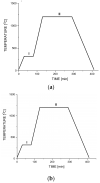Comparative Study of Porous Iron Foams for Biodegradable Implants: Structural Analysis and In Vitro Assessment
- PMID: 37367257
- PMCID: PMC10299352
- DOI: 10.3390/jfb14060293
Comparative Study of Porous Iron Foams for Biodegradable Implants: Structural Analysis and In Vitro Assessment
Abstract
Biodegradable metal systems are the future of modern implantology. This publication describes the preparation of porous iron-based materials using a simple, affordable replica method on a polymeric template. We obtained two iron-based materials with different pore sizes for potential application in cardiac surgery implants. The materials were compared in terms of their corrosion rate (using immersion and electrochemical methods) and their cytotoxic activity (indirect test on three cell lines: mouse L929 fibroblasts, human aortic smooth muscle cells (HAMSC), and human umbilical vein endothelial cells (HUVEC)). Our research proved that the material being too porous might have a toxic effect on cell lines due to rapid corrosion.
Keywords: biodegradable metals; corrosion; cytotoxic activity; iron; iron-based materials; porosity.
Conflict of interest statement
The authors declare no conflict of interest.
Figures









Similar articles
-
Physiomimetic biocompatibility evaluation of directly printed degradable porous iron implants using various cell types.Acta Biomater. 2023 Oct 1;169:589-604. doi: 10.1016/j.actbio.2023.07.056. Epub 2023 Aug 1. Acta Biomater. 2023. PMID: 37536493
-
Additively manufactured biodegradable porous iron.Acta Biomater. 2018 Sep 1;77:380-393. doi: 10.1016/j.actbio.2018.07.011. Epub 2018 Jul 6. Acta Biomater. 2018. PMID: 29981948
-
Corrosion behaviour of the porous iron scaffold in simulated body fluid for biodegradable implant application.Mater Sci Eng C Mater Biol Appl. 2019 Jun;99:838-852. doi: 10.1016/j.msec.2019.01.114. Epub 2019 Feb 11. Mater Sci Eng C Mater Biol Appl. 2019. PMID: 30889759
-
Additively manufactured biodegradable porous metals.Acta Biomater. 2020 Oct 1;115:29-50. doi: 10.1016/j.actbio.2020.08.018. Epub 2020 Aug 25. Acta Biomater. 2020. PMID: 32853809 Review.
-
Insight into the bioabsorption of Fe-based materials and their current developments in bone applications.Biotechnol J. 2021 Dec;16(12):e2100255. doi: 10.1002/biot.202100255. Epub 2021 Oct 4. Biotechnol J. 2021. PMID: 34520117 Review.
Cited by
-
Enhanced Experimental Setup and Methodology for the Investigation of Corrosion Fatigue in Metallic Biodegradable Implant Materials.Materials (Basel). 2024 Oct 22;17(21):5146. doi: 10.3390/ma17215146. Materials (Basel). 2024. PMID: 39517421 Free PMC article.
References
-
- Chesta F., Rizvi Z.H., Oberoi M., Buttar N. The Role of Stenting in Patients with Variceal Bleeding. Tech. Innov. Gastrointest. Endosc. 2020;22:205–211. doi: 10.1016/j.tige.2020.07.001. - DOI
-
- Zheng Y., Yang H. Metallic Biomaterials Processing and Medical Device Manufacturing. Elsevier; Amsterdam, The Netherlands: 2020. Manufacturing of Cardiovascular Stents; pp. 317–340.
Grants and funding
LinkOut - more resources
Full Text Sources

